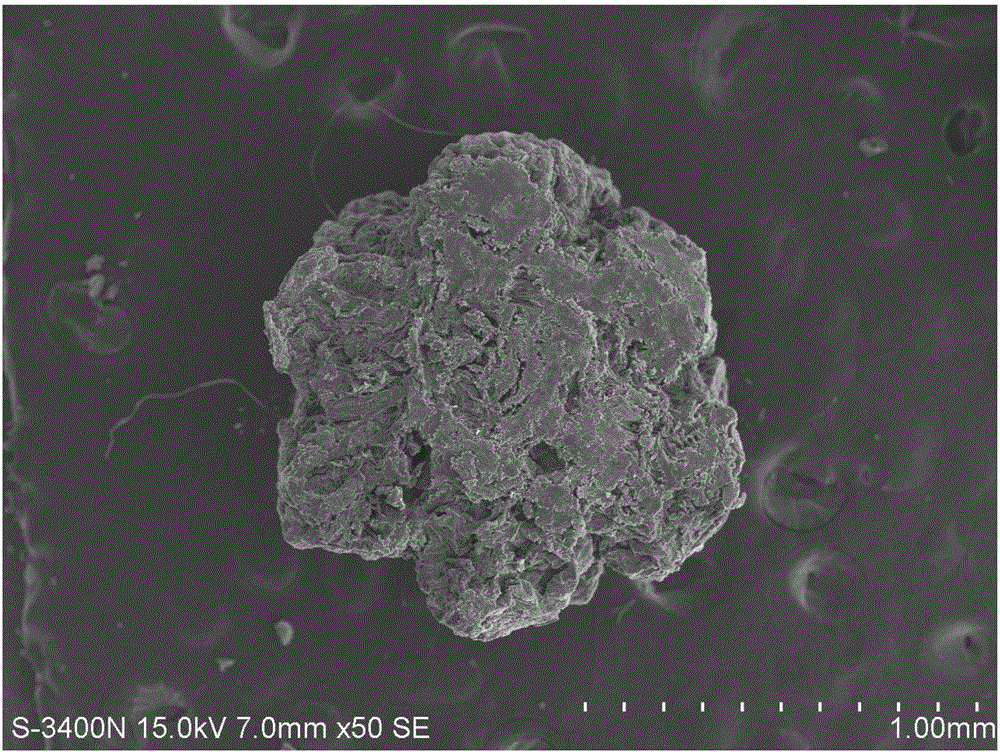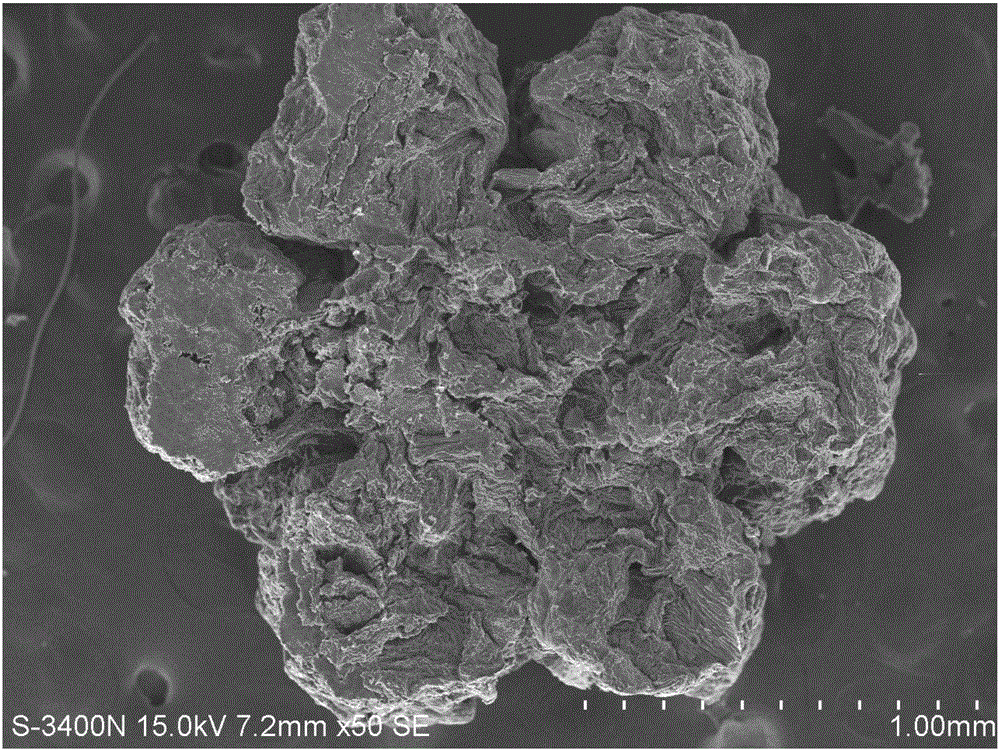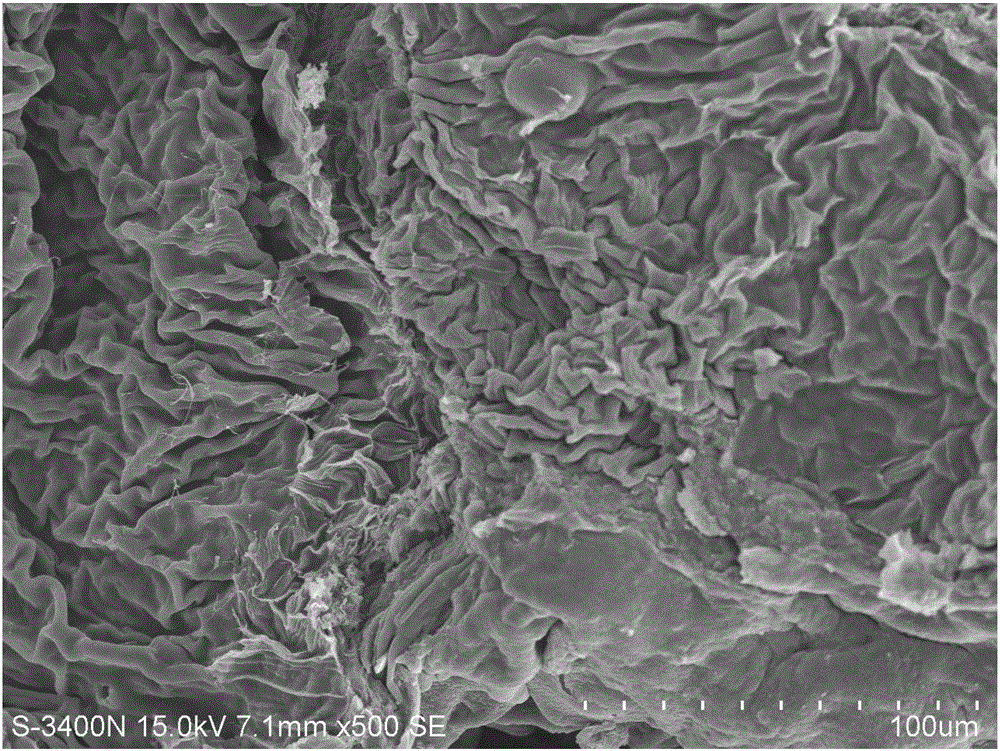N-doping surface modification silkworm excrement-based multi-stage hole carbon material and preparation method and application thereof
A surface modification and multi-level pore technology, applied in the field of carbon materials, can solve problems such as pollution, low efficiency of pesticide utilization, non-target biological damage to the environment, etc., and achieve high adsorption capacity, increase porosity and specific surface area.
- Summary
- Abstract
- Description
- Claims
- Application Information
AI Technical Summary
Problems solved by technology
Method used
Image
Examples
Embodiment 1
[0033] A preparation method of N-doped surface modified silkworm sand-based hierarchical porous carbon material, comprising the following steps:
[0034] (1) Mix the original silkworm sand with ZnCl with a mass concentration of 0.25 g / mL 2 The solution was mixed and swelled at 30°C according to the plastid ratio of 1:100 for 3.0h, and then the silkworm sand was taken out, and the silkworm sand was freeze-dried. It was first frozen at -20°C for 4 hours, and then cooled to -60°C for freezing. After drying for 24 hours, the lyophilized silkworm sand was obtained.
[0035] (2) Freeze-dried silkworm sand in N 2 The temperature was raised to 300°C at a heating rate of 5°C / min in the atmosphere, and the pore expansion reaction was carried out at 300°C for 5.0 h. After naturally cooling to room temperature, the obtained solid was dissolved in 1 mol / L HCl to wash and dissolve ZnCl. 2 , and then washed with deionized water to pH ≈ 7, centrifuged, placed in an oven to dry overnight, an...
Embodiment 2
[0038] (1) Mix the original silkworm sand with ZnCl with a mass concentration of 0.25 g / mL 2 The solution was mixed and swelled at 35°C according to the plastid ratio of 1:120 for 2.5 hours, and then the silkworm sand was taken out, and the silkworm sand was freeze-dried. It was first frozen at -20°C for 3 hours, and then cooled to -55°C for freezing. After drying for 36 hours, the lyophilized silkworm sand was obtained.
[0039] (2) The lyophilized silkworm sand was raised to 350°C at a heating rate of 5°C / min in an Ar atmosphere, and kept at 350°C for 4.0 h for pore-expansion reaction. After naturally cooling to room temperature, the obtained solid was dissolved in Wash and dissolve ZnCl in 1mol / L HCl 2 , and then washed with deionized water to pH ≈ 7, centrifuged, placed in an oven to dry overnight, and dried to obtain a silkworm sand-based hierarchical porous carbon material.
[0040] (3) Put 1.0g silkworm sand-based hierarchical porous carbon material into the plasma re...
Embodiment 3
[0042] (1) Mix the original silkworm sand with ZnCl with a mass concentration of 0.30 g / mL 2 The solution was mixed and swollen at 40°C according to the plastid ratio of 1:140 for 2.0h, and then the silkworm sand was taken out, and the silkworm sand was freeze-dried. It was first frozen at -25°C for 2 hours, and then cooled to -50°C for freezing. After drying for 48 hours, the lyophilized silkworm sand was obtained.
[0043] (2) Freeze-dried silkworm sand in N 2 In the atmosphere, the temperature was raised to 400°C at a heating rate of 5°C / min, and kept at 400°C for 3.0 h for pore expansion reaction. After naturally cooling to room temperature, the obtained solid was dissolved in 1 mol / L HCl to wash and dissolve ZnCl. 2 , and then washed with deionized water to pH ≈ 7, centrifuged, placed in an oven to dry overnight, and dried to obtain a silkworm sand-based hierarchical porous carbon material.
[0044] (3) Put 1.0g silkworm sand-based hierarchical porous carbon material in...
PUM
| Property | Measurement | Unit |
|---|---|---|
| Specific surface area | aaaaa | aaaaa |
| Total pore volume | aaaaa | aaaaa |
Abstract
Description
Claims
Application Information
 Login to View More
Login to View More - R&D
- Intellectual Property
- Life Sciences
- Materials
- Tech Scout
- Unparalleled Data Quality
- Higher Quality Content
- 60% Fewer Hallucinations
Browse by: Latest US Patents, China's latest patents, Technical Efficacy Thesaurus, Application Domain, Technology Topic, Popular Technical Reports.
© 2025 PatSnap. All rights reserved.Legal|Privacy policy|Modern Slavery Act Transparency Statement|Sitemap|About US| Contact US: help@patsnap.com



